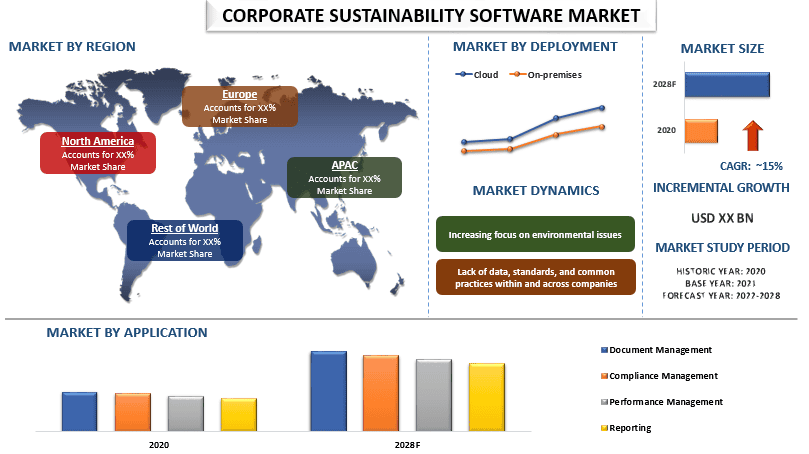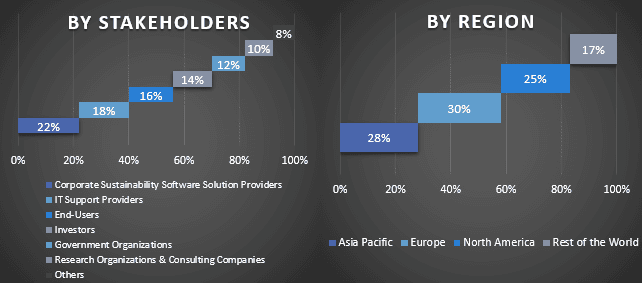- Home
- About Us
- Industry
- Services
- Reading
- Contact Us
Corporate Sustainable Software Market: Current Analysis and Forecast (2022-2028)
Emphasis on Deployment (Cloud and On-premises); Application (Document Management, Compliance Management, Performance Management, and Reporting); and Region/Country

The global Corporate Sustainability Software Market is expected to grow at a CAGR of 15% during the forecast period. The global corporate sustainability software market is growing on account of the increasing investments made by large organizations and governments across the globe for the advancements in technology for efficient use of the existing renewable and nonrenewable resources. Furthermore, the surge in environmental awareness and increase in concerns among organizations & individuals about global warming acts as the key driving forces of the global corporate sustainability software market. Moreover, the growing carbon emissions globally are increasing at an alarming rate, for instance, global energy-related CO2 emissions remained at 31.5 GT, which contributed to CO2 reaching its highest-ever average annual concentration in the atmosphere of 412.5 parts per million in 2020 – around 50% higher than when the industrial revolution began. These factors are expected to drive the market for the corporate sustainability software market.
Cority Software Inc., Novisto Inc., Intelex Technologies Inc., StarTex Software LLC., Tavares Group Consulting Inc., Locus Technologies, Key Green Solutions LLC, Emex Software Ltd, Diligent Corporation, and Sphera Solutions Inc. are some of the key players in the market. Several M&As along with partnerships have been undertaken by these players to facilitate customers with hi-tech and innovative products/technologies.
Insights Presented in the Report
“Amongst deployment, the on-premises segment held a prominent share of the market in 2020”
Based on deployment, the market is classified into on-premises and cloud. The on-premises segment captured a significant share of the global corporate sustainability software market and is expected to witness robust CAGR during the forecast period, owing to the high preference for this type of deployment to have complete control over confidential data and less dependency on the internet in case of internet interruption.
“Amongst application, performance management segment held a significant share of the market in 2020”
By application, the corporate sustainability software market is divided into document management, compliance management, performance management, and reporting. The performance management segment catered to a commendable share of the market in 2020 because it helps businesses align their resources, and systems to meet sustainability objectives. Any functions that evaluate data to show how a company’s sustainability practices are doing fall under the category of performance management. Access to configurable dashboards and benchmarking, which evaluates an organization’s performance in terms of sustainability or energy management in comparison to predetermined standards or those of other businesses, are important components.
“North America to hold a significant share in the market”
North America held a prominent share of the global corporate sustainability software market in 2020 and is expected to showcase a prominent growth rate during the forecast period. This can be attributed to the presence of leading sustainability and energy management software providers and the integration of cloud and IoT with corporate sustainability software market solutions. In addition, a surge in investments by key players as well as the government for developing advanced energy preservation technology and sustainability solutions fuels the growth of the market. In countries such as US and Canada, there are numerous government initiatives and investments. For instance, in 2020, the US government committed a federal investment of USD 1.7 Tn in climate resilience and clean energy over the course of the next 10 years, and the increasing cost of energy is expected to drive the market of the corporate sustainability software market in the region.
Reasons to buy this report:
- The study includes market sizing and forecasting analysis validated by authenticated key industry experts.
- The report presents a quick review of overall industry performance at one glance.
- The report covers an in-depth analysis of prominent industry peers with a primary focus on key business financials, product portfolios, expansion strategies, and recent developments.
- Detailed examination of drivers, restraints, key trends, and opportunities prevailing in the industry.
- The study comprehensively covers the market across different segments.
- Deep dive regional level analysis of the industry.
Customization Options:
The global corporate sustainability software market can further be customized as per the requirement or any other market segment. Besides this, UMI understands that you may have your own business needs, hence feel free to connect with us to get a report that completely suits your requirements.
Table of Content
Research Methodology for the Corporate Sustainability Software Market Analysis (2022-2028)
Analyzing the historical market, estimating the current market, and forecasting the future market of the global corporate sustainability software market were the three major steps undertaken to create and analyze the adoption of corporate sustainability software in major regions globally. Exhaustive secondary research was conducted to collect the historical market numbers and estimate the current market size. Secondly, to validate these insights, numerous findings and assumptions were taken into consideration. Moreover, exhaustive primary interviews were also conducted, with industry experts across the value chain of the global corporate sustainability software market. Post assumption and validation of market numbers through primary interviews, we employed a top-down/bottom-up approach to forecasting the complete market size. Thereafter, market breakdown and data triangulation methods were adopted to estimate and analyze the market size of segments and sub-segments of the industry pertains to. Detailed methodology is explained below:
Analysis of Historical Market Size
Step 1: In-Depth Study of Secondary Sources:
Detail secondary study was conducted to obtain the historical market size of the corporate sustainability software market through company internal sources such as annual reports & financial statements, performance presentations, press releases, etc., and external sources including journals, news & articles, government publications, competitor publications, sector reports, third-party database, and other credible publications.
Step 2: Market Segmentation:
After obtaining the historical market size of the corporate sustainability software market, we conducted a detailed secondary analysis to gather historical market insights and share for different segments & sub-segments for major regions. Major segments are included in the report as deployment and application. Further country-level analyses were conducted to evaluate the overall adoption of testing models in that region.
Step 3: Factor Analysis:
After acquiring the historical market size of different segments and sub-segments, we conducted a detailed factor analysis to estimate the current market size of the corporate sustainability software market. Further, we conducted factor analysis using dependent and independent variables such as deployment and application of the corporate sustainability software. A thorough analysis was conducted for demand and supply-side scenarios considering top partnerships, mergers and acquisitions, business expansion, and product launches in the corporate sustainability software market sector across the globe.
Current Market Size Estimate & Forecast
Current Market Sizing: Based on actionable insights from the above 3 steps, we arrived at the current market size, key players in the global corporate sustainability software market, and market shares of the segments. All the required percentage shares split, and market breakdowns were determined using the above-mentioned secondary approach and were verified through primary interviews.
Estimation & Forecasting: For market estimation and forecast, weights were assigned to different factors including drivers & trends, restraints, and opportunities available for the stakeholders. After analyzing these factors, relevant forecasting techniques i.e., the top-down/bottom-up approach were applied to arrive at the market forecast for 2028 for different segments and sub-segments across the major markets globally. The research methodology adopted to estimate the market size encompasses:
- The industry’s market size, in terms of revenue (USD) and the adoption rate of the corporate sustainability software market across the major markets domestically
- All percentage shares, splits, and breakdowns of market segments and sub-segments
- Key players in the global corporate sustainability software market in terms of products offered. Also, the growth strategies adopted by these players to compete in the fast-growing market
Market Size and Share Validation
Primary Research: In-depth interviews were conducted with the Key Opinion Leaders (KOLs) including Top Level Executives (CXO/VPs, Sales Head, Marketing Head, Operational Head, Regional Head, Country Head, etc.) across major regions. Primary research findings were then summarized, and statistical analysis was performed to prove the stated hypothesis. Inputs from primary research were consolidated with secondary findings, hence turning information into actionable insights.
Split of Primary Participants in Different Regions

Market Engineering
The data triangulation technique was employed to complete the overall market estimation and to arrive at precise statistical numbers for each segment and sub-segment of the global corporate sustainability software market. data was split into several segments & sub-segments post studying various parameters and trends in the areas of deployment and application in the global corporate sustainability software market.
The main objective of the Global Corporate Sustainability Software Market Study
The current & future market trends of the global corporate sustainability software market were pinpointed in the study. Investors can gain strategic insights to base their discretion for investments on the qualitative and quantitative analysis performed in the study. Current and future market trends determined the overall attractiveness of the market at a regional level, providing a platform for the industrial participant to exploit the untapped market to benefit from a first-mover advantage. Other quantitative goals of the studies include:
- Analyze the current and forecast market size of the corporate sustainability software market in terms of value (USD). Also, analyze the current and forecast market size of different segments and sub-segments
- Segments in the study include areas of deployment and application
- Define and analysis of the regulatory framework for the corporate sustainability software industry
- Analyze the value chain involved with the presence of various intermediaries, along with analyzing customer and competitor behaviors of the industry
- Analyze the current and forecast market size of the corporate sustainability software market for the major region
- Major countries of regions studied in the report include Asia Pacific, Europe, North America, and the Rest of the World
- Company profiles of the corporate sustainability software market and the growth strategies adopted by the market players to sustain in the fast-growing market
- Deep dive regional level analysis of the industry
Related Reports
Customers who bought this item also bought










